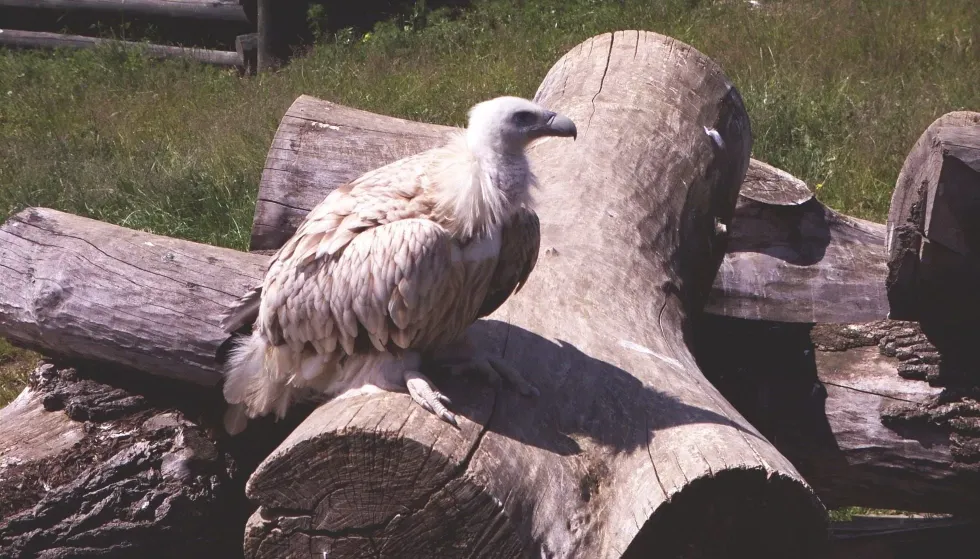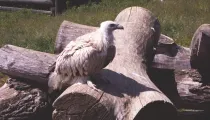The Himalayan vulture (Gyps himalayensis) is endemic to the Himalayas and the Tibetan Plateau. The species is also known as the Himalayan griffon vulture and it belongs to the group of Old World vultures. It is the largest species of the Gyps genus.
The species is primarily found in the uplands of central Asia and its range includes Kazakhstan, Afghanistan, western China, and Mongolia in the east. They can also be found in northern India, Pakistan, and Bhutan.
A vagrant population has also been recorded in Cambodia, Thailand, Singapore, and Myanmar. The Himalayan griffon vulture inhabits mountains, meadows, lowland plains, and alpine shrubs.
The Himalayan griffon vulture (Gyps himalayensis) is quite large. It has a stout bill, long wings, a feathered ruff, and a short tail.
Adults generally possess cream and blackish plumage, while juveniles have dark brown feathers and their head is a whitish color. Unlike the pale coverts and body, the tail and wing feathers are dark.
The average weight and length of the species are 18-27 lb (8 to 12 kg) and 37-51 in (95-130 cm), respectively. The wingspan varies from 8-10 ft (2.5-3 m), and cinereous vultures have a similar wingspan.
The IUCN has listed the species as Near Threatened. One major threat to the species is a nonsteroidal anti-inflammatory drug known as diclofenac. Their population decline is generally caused by the consumption of carcasses exposed to diclofenac.
Let's read more interesting facts about the Himalayan vulture, and if you find this article insightful, don't forget to check out exciting information about different animals like the swallow-tailed kite and the cockatoo.
Himalayan Vulture Interesting Facts
What type of animal is a Himalayan vulture?
The Himalayan griffon vulture (Gyps himalayensis) belongs to the group of Old World vultures that is endemic to the Himalayas and the adjoining Tibetan Plateau region. It is also known as the Himalayan vulture and the usual diet of the species includes yaks and antelopes.
What class of animal does a Himalayan vulture belong to?
The Himalayan griffon vulture (Gyps himalayensis) belongs to the class of Aves, the family of Accipitridae, and the genus Gyps. The genus Gyps consists of all species of Old World vultures.
How many Himalayan vultures are there in the world?
The population of these birds is declining rapidly, and there are around 100,000-499,999 individuals as of now. The population of mature individuals sits at around 66,000-334,000.
Where does a Himalayan vulture live?
The Himalayan griffon vulture (Gyps himalayensis) is primarily found in the uplands of central Asia and its range includes Kazakhstan, Afghanistan, western China, and Mongolia in the east, as well as northern India, Pakistan, and Bhutan. A vagrant population has also been recorded in Cambodia, Thailand, Singapore, and Myanmar.
What is a Himalayan vulture's habitat?
The typical Himalayan vulture habitat includes mountains, meadows, lowland plains, or alpine shrubs. These vultures forage at elevations of 16404 ft (5000 m) and more, while young birds spend their boreal winter in the south.
Who do Himalayan vultures live with?
Unlike other Old World vultures, Himalayan griffon vultures are quite social and they can be found in small colonies consisting of around four to six pairs. They usually dominate over other vultures such as cinereous vultures and Himalayan bearded vultures. During the breeding season, they are seen in pairs.
How long does a Himalayan vulture live?
The exact lifespan of the Himalayan griffon vulture is not known, but vultures, in general, live for around 25-30 years.
How do they reproduce?
Like other species of the Accipitridae family, Himalayan griffon (Gyps himalayensis) birds are monogamous which means that the breeding pairs remain the same throughout each bird's life. These vultures generally mate in the nest and not on the ground.
Their nests are seen at an elevation of 3,986- 5,971 ft (1215-1820 m) in northeastern India, while in the Tibetan Plateau, their nests have been observed at a height of 13,927 ft (4245 m).
No courtship displays have been observed as of now, but during the breeding season, the chest of the female bird generally turns red. The breeding season occurs between December and March, and both male and female birds are involved in the construction of nests.
Incubation lasts for around 54-65 days. Female birds incubate during the morning hours, while males take over during the afternoon and a single white egg is laid.
What is their conservation status?
The IUCN has listed these birds as Near Threatened. The major threat to the Himalayan griffon vulture is a nonsteroidal anti-inflammatory drug known as diclofenac. Their population decline is generally caused by the consumption of the carcasses of dead animals that have been exposed to diclofenac.
Himalayan Vulture Fun Facts
What do Himalayan vultures look like?
The Himalayan griffon (Gyps himalayensis) is quite large. It has a stout bill, long wings, a feathered ruff, and a short tail. Adults generally possess cream and blackish plumage, while juveniles have dark brown feathers and their head is of a whitish color. Unlike their pale coverts and body, their tail and wing feathers are dark.
How cute are they?
The Himalayan vulture is one of the most beautiful birds of India and the Tibetan region. The loud roaring calls of this vulture exhibit its dominance and power over other birds. Anyone would love to see this bird flying over the mountains of the Himalayas and surrounding regions.
How do they communicate?
Like other species of the Accipitridae family, this scavenger vulture relies on its eyesight to find the carcasses of dead animals. On the other hand, scavenger birds of the New World vultures rely predominantly on their sense of smell.
How big is a Himalayan vulture?
The average weight and length of this bird are 18-27 lb (8 to 12 kg) and 37-51 in (95-130 cm), respectively. The average Himalayan griffon vulture wingspan varies from 8-10 ft (2.5-3 m) and cinereous vultures have a similar wingspan.
How fast can a Himalayan vulture fly?
Adults can easily reach the speed of 30 mph (48 kph), and they become quite fast if they spot a carcass. They are known as carrion-eater specialists.
How much does a Himalayan vulture weigh?
The Himalayan vulture weighs around 18-27 lb (8 to 12 kg).
What are their male and female names of the species?
Male and female Himalayan griffon vultures are not known by any specific names; people generally call them either Himalayan griffon vultures or Himalayan vultures. Both males and females incubate and feed their chicks.
What would you call a baby Himalayan vulture?
The term chick is used to refer to a baby Himalayan griffon vulture.
What do they eat?
Like other species of the Accipitridae family, the Himalayan griffon vulture feeds on the carcass of dead animals. They form small groups around the food, and their usual diet includes carrion of yaks and antelopes.
Are they dangerous?
Like other vultures, the Himalayan griffon vulture is considered one of the most dangerous birds of the Himalayas. Along with long wings and a strong head, these birds possess heavy claws and sharp bills. They also attack in small colonies and the strike of these birds can cause several damages to humans and animals.
Would they make a good pet?
This carrion-eater is classified under the Near Threatened category by the IUCN and it is not allowed to keep them as pets. It is always suggested not to keep these birds as they generally die in captivity. Also, unlike other birds, they are very hard to tame.
Did you know...
The black vulture (Aegypius monachus) is regarded as the largest vulture in the world.
Around 10 species of vultures live in China.
Do Himalayan vultures migrate?
Himalayan vultures generally migrate altitudinally within their central Asian range, while a vagrant population has also been recorded in Cambodia, Thailand, Singapore, and Myanmar.
Are Himalayan vultures endangered?
The IUCN has listed the bird as Near Threatened. The most major threat to the Himalayan griffon vulture is a nonsteroidal anti-inflammatory drug known as diclofenac. Their population decline is generally caused by the consumption of carcasses of dead animals exposed to diclofenac.
Also, the number of nesting birds of this species is declining in several parts of Nepal. Humans have emerged as a major threat to them too. The best way to protect these birds is probably a reduction in the use of veterinary diclofenac.
Here at Kidadl, we have carefully created lots of interesting family-friendly animal facts for everyone to discover! Learn more about some other birds from our Hawaiian hawk facts and griffon vulture facts for kids.
You can even occupy yourself at home by coloring in one of our free printable Himalayan vulture coloring pages.










